The Impact of Bad Office Design on Employee Stress Levels ...and how you can make improvements!
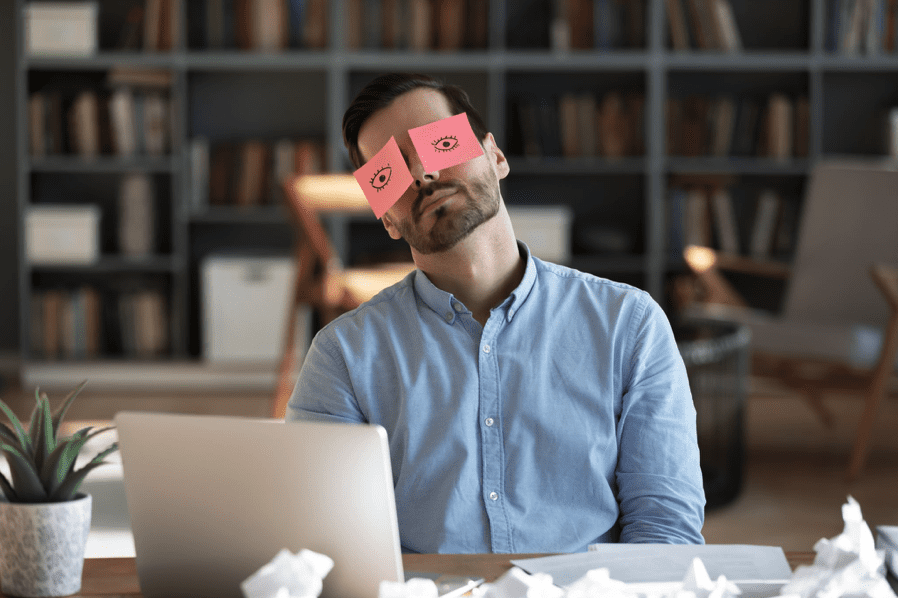
If as many as 4 out of every 5 people above the age of 18 regularly experience stress, then the workplace is surely where a good chunk of that number originates and, frankly, if your employees are stressed then you’re not going to be getting the best out of them.
One of the factors that could help reduce and manage stress levels is a comfortable, well-designed office that promotes wellbeing and actually enables staff to work.
We’ve – thankfully – all evolved from the depressing cubicles of the 80s and 90s, and modern offices can offer staff so much more than merely a place to be trapped every day.
With the expectations for interior decor being so high, today’s workplace must live up to the hype.
We totally know all that and yet, outdated office design is still one of the most common issues faced by workers. Yes, the corporate culture can go a long way when it comes to job satisfaction and employee engagement, but a business’ culture and values are also reflected in the workspace design.
If broken or tatty furniture, claustrophobic cubicles and lack of natural lighting are features of your office, it can tell a sad tale of neglect and an indication that your company probably needs to invest in some office renovation, or else risk increasingly low morale and dwindling staff retention.
Office Design and Employee Wellbeing
Talent Works reported that 85% of employees feel dissatisfied with their workplace, are unable to concentrate and that being able to work in a private environment was important. They also reported that strong office design can increase employee happiness by 33%! Now if that’s not a reason to consider an Office Refurbishment, what is?
It’s no secret that happy employees are much more productive in the workplace, wellbeing in the workplace should be an employer’s top priority to reduce stress and increase employee wellbeing.
Bad aesthetics and ergonomics can very easily negatively impact an employee’s mood, physical and mental strain. Sitting hunched over at a desk for extended periods slows down internal processes and lowers energy levels.
Too much sitting and poor posture prevents our internal systems from performing their functions properly. Long term, this contributes to irritability, depression, anxiety, and undue stress.
Let’s look at the way office interior design can make a difference…
Privacy in the workplace
Lack of privacy is an ongoing workplace issue. Privacy in the office has been a main concern we’ve experienced from our clients through our office design and fit-out’s in the last couple of years. If concentration is key to successfully and satisfactorily completing a task, a bad office layout can cause a whole load of distractions which hinder the employee’s concentration, and therefore their productivity.
Bad acoustics or annoying noise is one of those most common complaints in the office today. Sometimes companies nail the visual office design, but it’s easy to forget about good office acoustics if you haven’t got a professional on the job.
We always consider materials and furnishings that absorb sound, instead of letting it bounce around a room, particularly in shared, open offices, meeting rooms or areas where people may be on the phone often. We’ve covered a little more about acoustic-friendly furniture in this recent article.
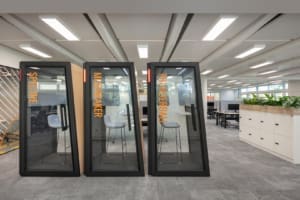
Acoustic office pods we recently installed in the KnowBe4 office, offering a quiet, private space for employees to crack on and get some work done.
Encourage employees to get moving
One of the most obvious physical factors of poor ergonomics is the daily aches and pains caused by the use of furniture that doesn’t fit with the workers body structure.
This can include chairs and desks, as sitting for long periods of time with bad posture causes muscle and joint paint. Longer-term, bad posture can also cause stomach discomfort, varicose veins due to poor circulation, and even have a negative effect on breathing. Computer monitors that are too low can cause eye strain or a hunched posture, and poorly positioned keyboards can cause aches or bruise the wrists or forearms.
Unsurprisingly, this physical strain adds to the mental load on employees and will have a negative impact on their performance. Now, we know working a 9-5 office jobs means you can’t be moving all the time, however, introducing height adjustable desks (also known as sit stand desks), for example, can make a tonne of difference. Posturite found that height adjustable desks were an effective intervention on wellbeing at work, and that improvements were found in stress levels, wellbeing, vigour and pain.
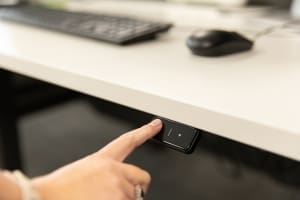
We installed sit stand desks in the the Firmenich office to give employees the option of sitting or standing when they were in the office.
Adding colour to your office design
Wall colouring can actually have a psychological impact on your staff. Choosing the wrong shade could be hampering happiness and productivity.
A study from the University of Texas found that white walls cause employees to make more mistakes while red walls are over-stimulating, increase the heart rate and can raise blood pressure. For promoting creativity, innovation and calm, blue and green were identified as being the best colours. In addition to painting things green, involving living greenery or faux greenery in the workplace is a great way to bring some colour into the office and has many other health benefits to boot, as we explored in our previous post about biophilic design.
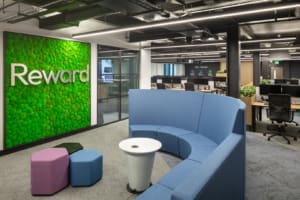
A full green wall in the Reward Finance office in the entrance area, showcasing their brand. Reward Finance also have lots of greenery situated around the office.
Good office design
A disorganised office layout or mess, chaotic surfaces can create extra tasks for staff, or make the existing tasks longer.
If its always takes you twice as long to find something, or you cant find it at all, you’re going to wind up frustrated and exhausted. Over time, this is tiring and absorbs energy which could be better spent on the actual job! It’s also another instance of something seemingly minor that adds up to overall job dissatisfaction.
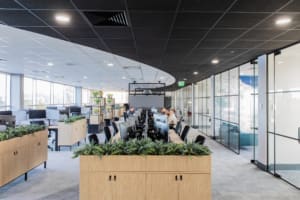
An example of a good open plan office layout is the Keepmoat HQ in Doncaster, with sufficient storage for every member of staff.
The lighting lowdown
Make sure you’re making the most of any windows in your office and use cool white or artificial daylight bulbs where possible.
A lack of natural light or bad lighting, such as fluorescent lighting, could be having an undesirable impact on your employees’ health and wellbeing, therefor impacting productivity. Poor lighting causes such delights as eyestrain, migraines and stress.
On the flipside, natural light has been shown to increase productivity, alertness and, interestingly, improves memory too!
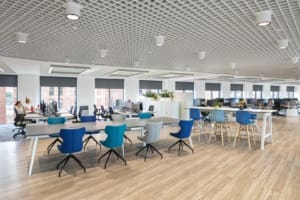
The team at Reed Smith are blessed with lots of natural light in their office space! We utilised this as much as we could when designing and space planning their workplace, ensuring that the desks were placed as close as possible to the natural light coming through the windows.
Happy, not snappy
People who socialise tend to be less stressed, either because they’re enjoying the friendly interaction and that balances out the negative, or because they have someone else to vent to about the stress!
Those in a friendly, sociable working environment that offers opportunities to mingle are more likely to be happier. Stressed staff are less likely to be in the mood to make friends, especially if there is little opportunity for them to do so and it isn’t encouraged by the workplace layout and company culture.
You can encourage collaboration through office design by utilising the space better, and creating different work zones, such as a breakout space.
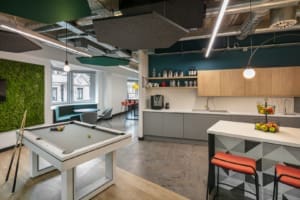
We created this social space (breakout space) for Appleyard Lees in Leeds, encouraging employees to take some time out, move around and socialise.
So what can you do about it?
If any of the above sounds familiar and you’re worried you’re heading towards some serious employee burnout, or even just less-than-happy staff, you might be thinking you’d like to tackle the issues head-on. When it comes to decreasing employees’ stress levels, there are a number of things you can do.
We can help you invest in better, more ergonomic furniture. It’ll be built for the specific purpose you need it for and most good office furniture is adjustable and reliable. This will go a long way to creating a more comfortable workspace.
Secondly, you could take a little look at the break out areas. Where possible encourage workers to take breaks, allow them to socialise, ensure healthy snacks are available and that movement is optional throughout the day. A refreshed worker is far less likely to experience stress or burnout and much more likely to be firing on all cylinders for you.
If you need a little professional help to implement any changes in your office and would like to speak to one of our team, we’d love to hear from you.
